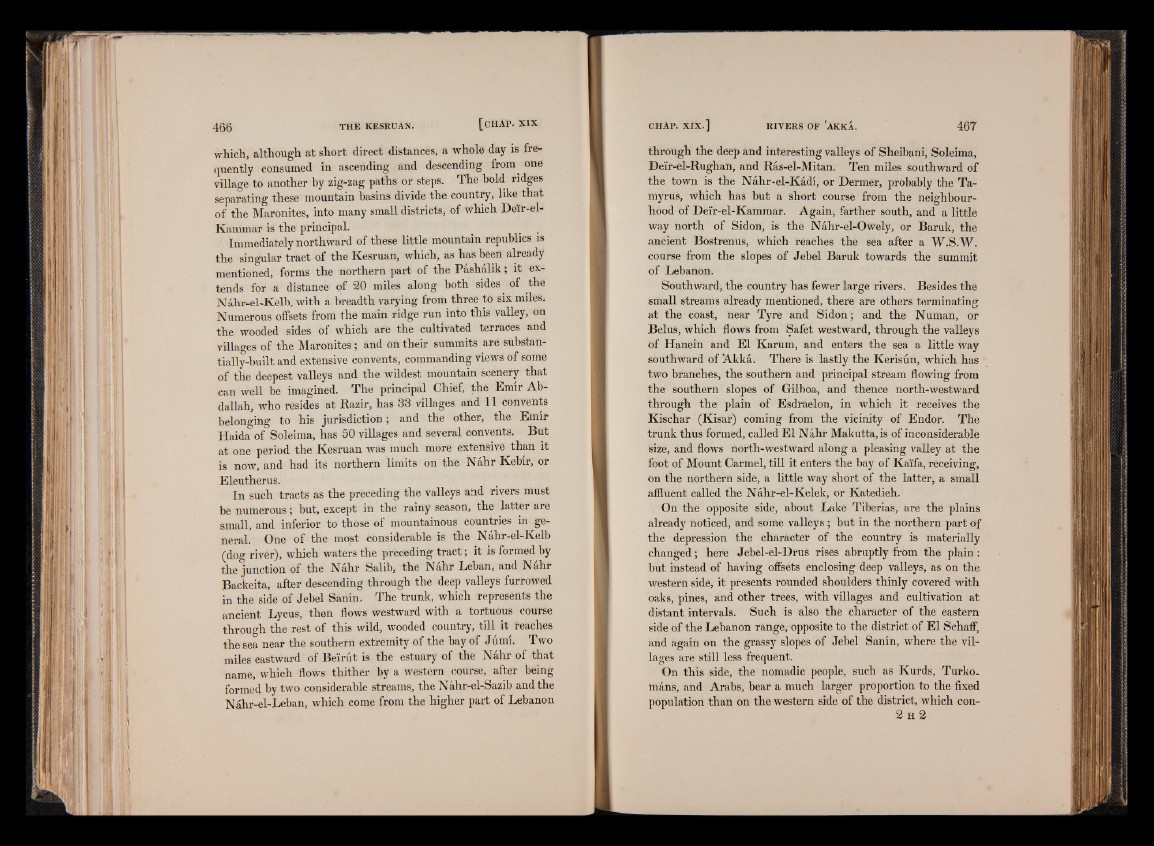
which, although at short direct distances, a whole day is frequently
consumed in ascending and descending from one
village to another by zig-zag paths or steps. The bold ridges
separating these mountain basins divide the country, like that
of the Maronites, into many small districts, of which De'ir-el-
Kammar is the principal.
Immediately northward of these little mountain republics is
the singular tract of the Kesruan, which, as has been already
mentioned, forms the northern part of the Pashalik; it extends
for a distance of 20 miles along both sides of the
Nahr-el-Kelb, with a breadth varying from three to six miles.
Numerous offsets from the main ridge run into this valley, on
the wooded sides of which are the cultivated terraces and
villages of the Maronites; and on their summits are Substantially
built and extensive convents, commanding views of some
of the deepest valleys and the wildest mountain scenery that
can well be imagined. The principal Chief, the Emir Ab-
dallah, who resides at Razir, has 33 villages and 11 convents
belonging to his jurisdiction; and the other, the Emir
Haida of Soleima, has 50 villages and Several convents. But
at one period the Kesruan was much more extensive than it
is now, and had its northern limits on the Nahr Kebir, or
Eleutherus.
In such tracts as the preceding the valleys and rivers must
be numerous; but, except in the rainy season, the latter are
small, and inferior to those of mountainous countries in general.
One of the most considerable is the Nahr-el-Kelb
(dog river), which waters the preceding tract; it is formed by
the junction of the Nahr Salib, the Nahr Leban, and Nahr
Backeita, after descending through the deep valleys furrowed
in the side of Jebel Sanin. The trunk, which represents the
ancient Lycus, then flows westward with a tortuous course
through the rest of this wild, wooded country, till it reaches
the sea near the southern extremity of the bay of Jumi. Two
miles eastward of Beirut is the estuary of the Nahr of that
name, which flows thither by a western course, after being
formed by two considerable streams, the Nahr-el-Sazib and the
Nahr-el-Leban, which come from the higher part of Lebanon
through the deep and interesting valleys of Sheibani, Soleima,
Deïr-el-Rughan, and Râs-el-Mitan. Ten miles southward of
the town is the Nâhr-el-Kâdi, or Dermer, probably the Ta-
myrus, which has but a short course from the neighbourhood
of Dei'r-el-Kammar. Again, farther south, and a little
way north of Sidon, is the Nahr-el-Owely, or Baruk, the
ancient Bostrenus, which reaches the sea after a W.S.W.
course from the slopes of Jebel Baruk towards the summit
of Lebanon.
Southward, the country has fevver large rivers. Besides the
small streams already mentioned, there are others terminating
at the coast, near Tyre and Sidon; and the Numan, or
Belüs, which flows from Safet westward, through the valleys
of Hanein and El Karum, and enters the sea a little way
southward of Akka, There is lastly the Kerisun, which has
two branches, the southern and principal stream flowing from
the southern slopes of Gilboa, and thence north-westward
through the plain of Esdraelon, in which it receives the
Kischar (Kisar) coming from the vicinity of Endor. The
trunk thus formed, called E l Nahr Makutta, is of inconsiderable
size, and flows north-westward along a pleasing valley at the
foot of Mount Carmel, till it enters the bay of Ka'ifa, receiving,
on the northern side, a little way short of the latter, a small
affluent called the Nahr-el-Kelek, or Katedieh.
On the opposite side, about Lake Tiberias, are the plains
already noticed, and some valleys ; but in the northern part of
the depression the character of the country is materially
changed; here Jebel-el-Drus rises abruptly from the plain:
but instead of having offsets enclosing deep valleys, as on the
western side, it presents rounded shoulders thinly covered with
oaks, pines, and other trees, with villages and cultivation at
distant intervals. Such is also the character of the eastern
side of the Lebanon range, opposite to the district of El Schaff,
and again on the grassy slopes of Jebel Sanin, where the villages
are still less frequent.
On this side, the nomadic people, such as Kurds, Turkomans,
and Arabs, bear a much larger proportion to the fixed
population than on the western side of the district, which con-
2 h 2